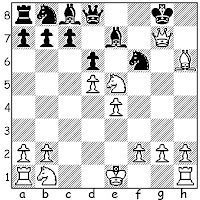The last two posts have shown the dangers that can befall Black if he does not react properly to 5.c3 in the Jerome Gambit. (For an oddly related game, see "Radioactive". Ouch!)
However, as others and I have shown - for an example, see one of my games in the 2008 ChessWorld.net Jerome Gambit thematic tournament - Black certainly has adequate resources.
(Ah, that was a tourney to remember! Although my success was "Overrated!" I was happy to take first place, three points ahead of the field, with a score of 16-2-0, winning 7 out of 9 games with White - and 9 out of 9 games with Black.)
The following game shows Black taking advantage of one downside of 5.c3 - Black can play 5...d5, and after 6.exd5 Qxd5 White does not have the natural hit at the Queen, Nc3.
Knight32 - AsceticKingK9
ChessWorld Jerome Gambit Thematic Tournament, 2011
1.e4 e5 2.Nf3 Nc6 3.Bc4 Bc5 4.Bxf7+
4...Kxf7 5.c3 d5 6.exd5 Qxd5 7.O-O Nf6 8.d3 Bf5
White needs some ideas here, and what he comes up with is not enough to steer the game in his direction.
9.Ng5+ Ke8 10.Nd2 Bxd3 11.Re1 h6 12.Ngf3 Kd7
13.b4 Bd6 14.Nb3 Rae8 15.Be3 e4 16.Nfd4 Nxd4 17.Bxd4 b6 18.Bxf6 gxf6 19.Qg4+ Kc6 20.Nd2 Rhg8 21.Qd1
The position looks ripe for a concluding sacrificial attack that ends in checkmate.
21...Bxh2+ 22.Kxh2 Rxg2+ 23.Kxg2 Rg8+ 24.Kh2 Qg5
White resigned
The defender who plays timidly against the Jerome Gambit is likely to face some annoying, advancing "Jerome pawns". This is especially the case in the 5.c3 "modern" variation of the opening, as seen in the game below.
GmCooper - ddp
blitz, FICS, 2000
1.e4 e5 2.Nf3 Nc6 3.Bc4 Bc5 4.Bxf7+
4...Kxf7 5.c3 h6
One can't be too careful, I guess.
6.d4 exd4 7.cxd4 Be7
8.d5 Nb8
This is too much timidity, as White quickly shows.
9.Ne5+ Kf8 10.Ng6+ Kf7 11.Nxh8+ Kf8 12.Ng6+ Kf7 13.Qh5
White is ahead the exchange and a pawn, and has the initiative.
13...Nf6 14.Ne5+ Kg8 15.Qf7+ Kh7 16.Qg6+ Kg8 17.Bxh6 d6
Black could have mobilized a defense of his King with 17...Qf8 18.Nc3 d6 19.Nd3 Bd7 20.0-0 Be8 21.Qg3 Nbd7 22.Be3 when he would simply be behind in material.
Instead, he ends the pain.
18.Qxg7 checkmate
When Alonzo Wheeler Jerome played his gambit in the late 1800s and early 1900s, he aways followed up 1.e4 e5 2.Nf3 Nc6 3.Bc4 Bc5 4.Bxf7+ Kxf7 with 5.Nxe5+, the move that I use to mark the "classical" side of the opening.
More recently, we have seen a selection of 5th move alternatives for White - 5.c3, 5.d3, 5.0-0, to give a few examples - so I have referred to the "not-5.Nxe5+" lines as those leading to the "modern" Jerome Gambit.
In "Ask Houdini" I indicated that it was time to take a closer look at the "modern" 5.c3. The earliest examples that I have of the move in the nearly 29,000 games of The Database are some blitz and lightning games played online at FICS by JeffreyOM from 1999 and 2000. Admittedly, this finding is of only slight historical interest, as my games collection is overwhelmingly drawn from FICS games, starting in 1999; although it can be pointed out that I have yet to find an over-the-board game with 5.c3, from any year.
In any event, here is a modern game with the modern line by a couple of modern players.
Wall,B - Zois
Chess.com, 2010
1.e4 e5 2.Nf3 Nc6 3.Bc4 Bc5 4.Bxf7+ Kxf7 5.c3
Here we go. White decides to limit his generosity and not sacrifice a second piece. He prepares for a large pawn center, and, in some cases, he can bring his Queen to that a2-g8 diagonal.
5...d6
A reasonable response, although Houdini 3 prefers 5...d5. Interestingly enough, The Database has 162 games with 5...d6 (White wins 44%) and only 38 with 5...d5 (White wins 20%). This is reminiscent of Bill's reflection: why worry about a refutation if no one plays it?
6.d4 Bb6
7.dxe5 dxe5
A couple of alternative moves:
7...Nxe5?! 8.Nxe5+ dxe5? (8...Kf8 9.Qf3+ Nf6 10.Nc4 Bc5 11.e5 dxe5 12.Nxe5 Qe7 13.Bf4 h6 14.0-0 Kg8 15.Ng6 Black resigned, thmavz - miomatteo, FICS, 2011) 9.Qxd8 Black resigned, thmavz - Richad, FICS, 2012; and
7...Bg4?! 8.Ng5+? Kf8? 9.Qxg4 Qe7 10.e6 Nf6 11.Qh3 h6 12.0-0 Ne8 White resigned (this looks like a loss on time - Rick), manago - savage13, Chessworld.net, 2008.
8.Nxe5+ Ke8 9.Qh5+ g6 10.Nxc6 gxh5 11.Nxd8 Kxd8
Objectively, Black's extra piece outweighs White's 2 extra pawns, especially if you consider that he has the two Bishops. However, this is the kind of position for White that a Jerome Gambiteer is likely to be both familiar and comfortable with.
12.a4 Nf6
That didn't take long. Black is happy with his advantage, he sees nothing to fear on the Queenside, so he confidently develops his Kingside - and drops a piece. Even when defending against the Jerome Gambit, your game will not play itself.
13.Bg5 Ke7 14.e5 Rg8 15.Bxf6+ Ke6 16.g3 c5 17.f4 Bd7
18.Rf1 Bc6 19.f5+ Kd5
Black's King should stay on the Kingside to help defend against the "Jerome pawns". He can probably keep them from Queening, but only at the cost of significant material.
20.c4+ Kxc4 21.Rf4+ Kd5 22.Nc3 checkmate
















